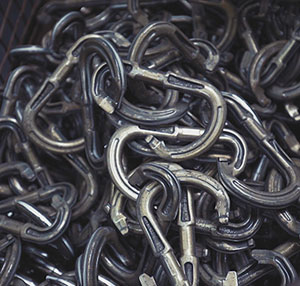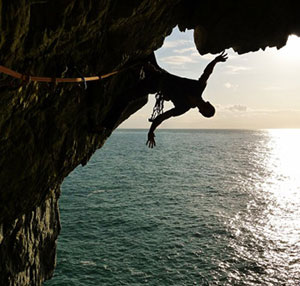A Beginner's Guide to Climbing
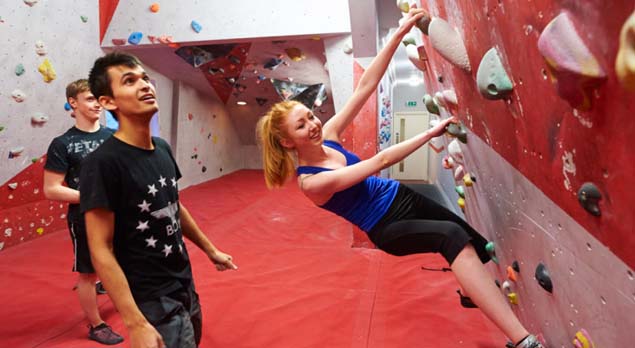
Climbing is a sport of highs and lows. It can have its frustrating moments, but that overwhelming sense of exhilaration and achievement when you nail a project makes it all worthwhile.
Like any sport, at a glance climbing can sometimes appear a little cliquey, with all its technical vocabulary, ethics and rules, and associated 'hippy' climber image. But in reality, the majority of climbers are a friendly, chatty, bunch of people who welcome first-timers to the sport with open arms, often offering helpful tips, advice and the frequently-heard "have you tried doing it this way...?"
The guide below is designed to help make your first exploits into the world of climbing a little bit easier, providing you with an overview of the different climbing disciplines, the gear, essential vocabulary and courses to get you started.
Climbing Disciplines
Climbing can be broken down into several different disciplines, each of which requires particular skills and equipment.
Bouldering
Climbing shoes, chalk and a bouldering mat are all you need to go bouldering. The focus is on using a combination of climbing techniques, precision footwork and often more dynamic moves without the aid of a rope in order to scale the rock face.
A bouldering mat[s] and a spotter (a friend to help redirect your controlled fall) are safety measures utilised at the bottom of the routes, which are rarely more than six metres in height. Indoor bouldering centres such as The Climbing Academy are a great place for first-time boulderers to get their skills honed before taking to real rock.
Sport Climbing
Sport climbing can be done either indoors or out, with the rock or wall featuring permanent bolts or other secure anchor points. Climbers then clip their rope into these anchors using quickdraws (2 snapgate karabiners joined by a sling) as they progress along the route, whilst being belayed by a partner. The act of clipping your rope in as you climb is also known as leading.
Top Roping
Top roping refers to a sport climb where the rope is already threaded through an anchor at the top of the route, removing the need to lead the route. The assisting climber takes up the slack the higher you get up the wall, eliminating the risk of a long fall.
Trad Climbing
Trad or traditional climbing involves the placement of various gear (cams, nuts, hexes) into gaps or cracks in the rock face to create anchor points as the climber ascends. The climber then proceeds to clip the rope into these anchors using quickdraws as they travel up, limiting the height of any fall. Efficient gear placement is key to ensuring the route remains as safe as possible.
Aid Climbing
Put simply, aid climbing is the practice of ascending a rock face using ropes, tools and other equipment. Climbers then pull themselves up the face relying on strength rather than specific climbing techniques. This is often used when creating new routes for other climbers.
Free Soloing
This is the scary one! Free soloers make an ascent of a rock face without the use of any safety equipment or ropes and is purely reliant on their expertise not to fall.
Deep Water Soloing (DWS)
Just like free soloing, this form of climbing doesn’t require a rope or a harness, however the route takes place above the sea (usually tide dependent) meaning any fall would be into water.
Via Ferrata
'Via ferrata' comes from the Italian for 'Iron Way'. It was born in the Dolomites during the First World War, when soldiers would insert iron rungs and cables into the mountain face to create laddered routes. The practice involves clipping yourself on to a steel cable which runs alongside the route for safety. Via Ferrata is more akin to scrambling rather than requiring out-and-out climbing.
Essential Climbing Equipment
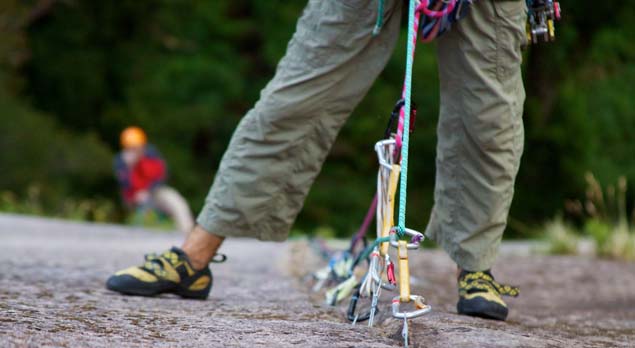
You really only need a few basic pieces of kit to start climbing, especially when bouldering or sport climbing. You can add to your gear over time as you develop a preference for a certain style or discipline. Many indoor climbing centres have equipment available for rental, meaning you can get a taster of climbing before taking the plunge, but the items below are the foundation of your climbing gear.
- Climbing harness package – includes: Momentum SA harness, ATC belay device, locking carabiner, chalk bag and White Gold chalk.
- Rope bag – keeps your rope dirt-free; important for safety and extends the life of the rope.
- Rope – made from multiple layers for strength, very easy to handle/keep tidy and can be used indoors or outside.
- Hand lube – repairs and soothes worn hands after tough climbs.
- Finger tape – helps to protect tendons/joints.
- Technical t-shirt – stretchy, lightweight and breathable, these tees allow for a wide range of movement and comfort.
- Climbing pants - made from stretchy, hard wearing fabric with an ergonomic shape for increased mobility when climbing.
- Climbing shoes - specifically designed for a precise fit and a sticky rubber sole which allows you to climb indoor or outdoor routes with greater ease.
Climbing Centres
The number of climbing centres in the UK has increased massively over the last decade with a big focus on making the sport more accessible. Centres now offer various beginner courses, women’s only sessions and lessons for children as young as five.
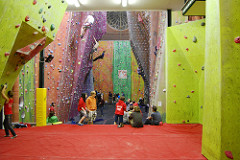
Manchester Climbing Centre
Bouldering, top rope and sport climbing are available at MCC with cheap introduction sessions available. The centre is especially good for social climbing/beginners and has women-only evenings once a week.
Find out more about Manchester Climbing Centre.
Glenmore Lodge
The centre has access to some excellent outdoor rock climbing. It is a great place to introduce yourself to trad climbing, receive world-class coaching and hone moves on their indoor wall.
Find out more about Glenmore Lodge.
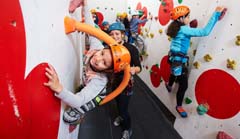
The Climbing Academy
Based in Bristol and Glasgow TCA mainly focus on bouldering, however, they have recently opened a separate roped centre in Bristol.
Find out more about The Climbing Academy.
Common Climbing Terminology
Climbers have their own unique language which can sound kind of strange at first but you will soon get used to it.
- Smearing – pressing the sole of your shoe into the wall for grip because there are no footholds.
- Leading - the climber places anchors and attaches the belay rope as they climb (traditional) or clips the rope into pre-placed equipment (sport).
- Multi-pitch climbing - a climbing route that requires multiple belay set-ups.
- Rainbow – using any holds you want to when climbing an indoor route.
- Overhang - a section of rock that hangs beyond vertical.
- Slab – a low-angle (much less than vertical) rock face.
- Pay out – the action of providing slack in the rope to a lead climber.
- Grade - describes the difficulty and danger of climbing the route.
- Jug - a large, easily held hold.
- Jib - a very small foothold, generally only large enough for the big toe.
- Barndoor - similar to the action of a door opening, a climber swings away from the rock face due to being unbalanced.
- Face - the front of the rocks that make up a climbing route .
- Crux - the most technical part of a climb.
- Rack - a collection of climbing protection.
- Second - the second person to ascend a climb, following the lead.
- Spotter - helps to break the fall of someone bouldering, directing them toward a mat.
- Dyno - a dynamic move, often involves a jump of some sort to the next hold .
- Edging - use of the edge of the feet on small, thin footholds.
- Top out - a climber reaches the top of their intended route.
- Fist Jam - a climber jams their fist into a crack which acts as an anchor for upwards movement .
- Bomb-proof or Bomber - confidence in the protection placed - “that nut is bomb-proof”.
- Protection - climbing devices which a climber attaches to the rock and then the rope is attached to the devices; helping to prevent a long fall.
- Crimp - a useful climbing grip for use on small, thin holds.
If you want any advice about climbing equipment please feel free to ring our experts or pop into a store and have a chat with our experienced staff.
You May Also Be Interested In...
![]()
About the Author:Pete Fletcher - Outdoor ExpertPete grew up hiking most of the trails in the Lake District before being introduced to skiing. A decade later and you're most likely to find him snowboarding, skateboarding or making a mean coffee. |

